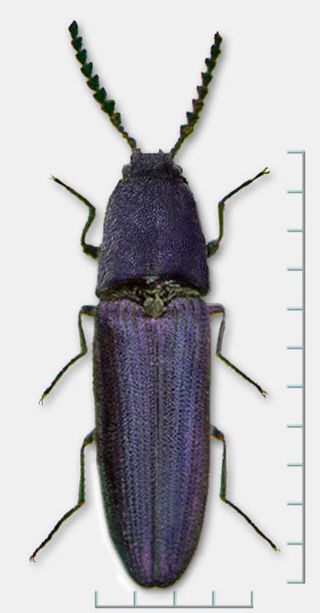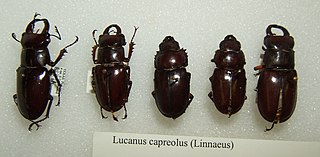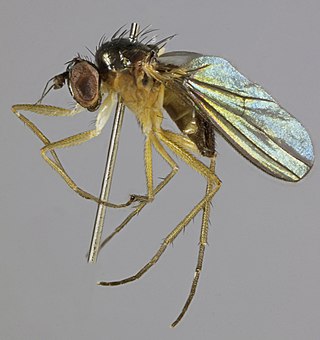
The longhorn beetles (Cerambycidae), also known as long-horned or longicorns, are a large family of beetles, with over 35,000 species described.

Darkling beetle is the common name for members of the beetle family Tenebrionidae, comprising over 20,000 species in a cosmopolitan distribution.

The violet click beetle is a black beetle, 12 mm (0.5 in) long, with a faint blue/violet reflection. It gets its name from the family habit of springing upwards with an audible click if it falls on its back. It occurs in Europe.

The Mydidae, or Mydas flies, are a cosmopolitan family of flies. It is a small family, with about 471 species described. They are generally large in size, including the largest known fly, Gauromydas heros. Many of the species, in addition to their large size, are mimics of stinging hymenopterans, especially wasps.

Prostomidae is a family of beetles with no vernacular common name, though recent authors have coined the name jugular-horned beetles. They are often found in dead wood. The family consist of two extant genera with about 20 species. Prostomis americanus is known from North America. Other species of Prostomis are found in Europe, Africa, the Pacific region and East Asia. Species of Dryocora are known from New Zealand, Australia and Tasmania.

Dolichopodidae, the long-legged flies, are a large, cosmopolitan family of true flies with more than 8,000 described species in about 250 genera. The genus Dolichopus is the most speciose, with some 600 species.

Brentidae, sometimes known as the primitive weevils, is a cosmopolitan family of primarily xylophagous beetles also known as straight-snouted weevils. The concept of this family has been expanded with the inclusion of three groups formerly placed in the Curculionidae; the subfamilies Apioninae, Cyladinae, and Nanophyinae, as well as the Ithycerinae, previously considered a separate family. They are most diverse in the tropics, but occur throughout the temperate regions of the world. They are among the families of weevils that have non-elbowed antennae, and tend to be elongate and flattened, though there are numerous exceptions.

A wood-decay or xylophagous fungus is any species of fungus that digests moist wood, causing it to rot. Some species of wood-decay fungi attack dead wood, such as brown rot, and some, such as Armillaria, are parasitic and colonize living trees. Excessive moisture above the fibre saturation point in wood is required for fungal colonization and proliferation. In nature, this process causes the breakdown of complex molecules and leads to the return of nutrients to the soil. Wood-decay fungi consume wood in various ways; for example, some attack the carbohydrates in wood, and some others decay lignin. The rate of decay of wooden materials in various climates can be estimated by empirical models.

Lucanus capreolus, the reddish-brown stag beetle or pinching beetle, is a beetle of the family Lucanidae. The specific name capreolus is derived from Latin, meaning "roe deer". The name refers to the resemblance of the mandibles to deer antlers.

The diabolical ironclad beetle is a beetle in the Phloeodes genus. It is native to the California Floristic Province in the states of California and Baja California, where it is believed to eat fungi growing under rotting tree bark. It is flightless and has a remarkably long adult lifespan of eight years, compared to the weeks or months of most adult beetle lifespans.

Anepsiomyia is a genus of flies in the family Dolichopodidae. It contains only one extant species from Europe, Anepsiomyia flaviventris, as well as two fossil species from the Eocene of Russia and Belarus. The systematic position of the genus is currently uncertain: it has been variously placed in subfamilies such as Sympycninae and Peloropeodinae.

The Trictenotomidae are a small family of beetles in the superfamily Tenebrionoidea, containing fifteen species in two genera. Most species are found in the Oriental realm where they live in montane forest habitats. The family is considered, based on larval characters as well as sequence-based studies, to be closely related to the Salpingidae.
Trachelostenus is a genus of darkling beetles in the family Tenebrionidae. It is native to the Valdivian forests of Chile, and has at least two species, T. inaequalis (Solier) and T. fascicularis (Philipp). It was historically considered the only member of the family Trachelostenidae, but a 2015 study sunk the genus into the tenebrionid subfamily Tenebrioninae.

The Ulodidae are a family of beetles belonging to Tenebrionoidea. They are native to the Southern Hemisphere, with species found in Australia, New Zealand, New Caledonia and Chile. Larvae and adults are generally found on dead wood or fungus associated with rotting wood, and are mycophagous. There are approximately 40 species in 16 genera.

Peripatopsidae is one of the two living velvet worm families. This family includes more than 140 described species distributed among 41 genera, but some authorities deem only 131 of these species to be valid. The French zoologist Eugène Louis Bouvier proposed this family in 1905 with Peripatopsis as the type genus.

Blosyropus spinosus, also known as the spiny longhorn or spiny silver-pine borer, is a rare species of longhorn beetle endemic to New Zealand. It has no specific Māori name, but the term for large longhorns of this type are howaka and kapapa.
Metaperipatus is a genus of velvet worms in the family Peripatopsidae that contains two species found in Chile, including Metaperipatus inae. This genus was created by the American zoologist Austin Hobart Clark in 1913 to contain the type species, M. blainvillei. Authorities believe M. blainvillei is a species complex, however, and some consider M. blainvillei a nomen dubium.

Iphthiminus is a genus of darkling beetles in the subfamily Tenebrioninae.

Parisopalpus nigronotatus, known by its common name, the spotted lax beetle, is a species of false blister beetles. It was first identified by Carl Henrik Boheman in 1858, under the name Nacerdes nigronotata. Native to eastern Australia, the species was introduced to New Zealand in 1931.

Figulus is a genus of beetle in the family Lucanidae. They have a paleotropical distribution, including occurrences in Australia.



















